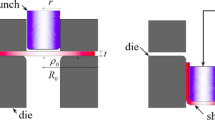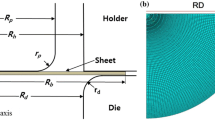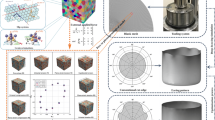Abstract
Crystallographic texture causes anisotropic formability of metal sheets, which results in the formation of uneven cup heights during deep drawing, called earing. Over the past decades, several methods had been developed to predict the earing behaviour of aluminium alloys. These methods are rather complex and can only be applied within strict sheet thickness ranges. Recently, a simple method has been presented and successfully applied on different sheet thicknesses. The method relies solely on {h00} type pole figure data. However, it is desired to be able to predict earing from other reflections as well. In this manuscript, a method which predicts the type and magnitude of earing only from the data of {111} pole figure measurements, is presented. The method was applied on a series of 0.3 and 3 mm thick cold rolled and annealed aluminium sheets, exhibiting rolling and recrystallization textures and the combination of these. It is shown that the proposed method gave similar results to those of deep drawing tests. It is concluded that using the presented method, the earing of aluminium sheets can be characterized solely from {111} pole figure measurement data.





Similar content being viewed by others
REFERENCES
T. Sheppard and M. A. Zaidi, Met. Tecnol. 9, 368 (1982).
O. Engler, Mat. Sci. Eng. A 538, 69 (2012).
W. B. Hutchinson, A. Oscarsson, and A. Karlsson, Mat. Sci. Tecnol. 5, 1118 (1989).
X.-M. Cheng, J. Mater. Eng. Perform. 10 (4), 399 (2001).
Z. Zhao, W. Mao, F. Roters, and D. Raabe, Acta Mater. 52, 1003 (2004).
S. Fukui and H. Kudo, Rep. Inst. Sci. Tech. Univ. Tokyo 4, 33 (1950).
R. Sowerby and W. Johnson, J. Strain Anal. 9, 102 (1974).
C. S. Da Costa Viana, G. J. Davies, and J. S. Kallend, in Proceedings of the Fifth International Conference on Textures of Materials (Aachen, 1978), p. 447.
P. Van Houtte, G. Cauwenberg, and E. Aernoudt, Mat. Sci. Eng. 95, 115 (1987).
O. Engler and S. Kalz, Mat. Sci. Eng. A 373, 350 (2004).
O. Engler and J. Hirsch, Mat. Sci. Eng. A 452‒453, 640 (2007).
O. Engler, L. Löchte, and J. Hirsch, Acta Mater. 55, 5449 (2007).
O. Engler, N. Mertens, and P. Van Dam, J. Mater. Process. Tech. 211, 1278 (2011).
M. Benke, A. Hlavacs, I. Piller, et al., Eur. J. Mech. A Solids 81, 103950 (2020).
M. Sepsi, V. Mertinger, and M. Benke, Mat. Char. 151, 351 (2019).
Funding
This work was supported by the János Bolyai Research Scholarship of the Hungarian Academy of Sciences. Texture measurements were carried out within the NKFIH K119566 project.
Author information
Authors and Affiliations
Corresponding author
Rights and permissions
About this article
Cite this article
Benke, M. Prediction of Earing of Aluminium Sheets from {111} Pole Figures. Crystallogr. Rep. 65, 980–984 (2020). https://doi.org/10.1134/S1063774520060061
Received:
Revised:
Accepted:
Published:
Issue Date:
DOI: https://doi.org/10.1134/S1063774520060061




